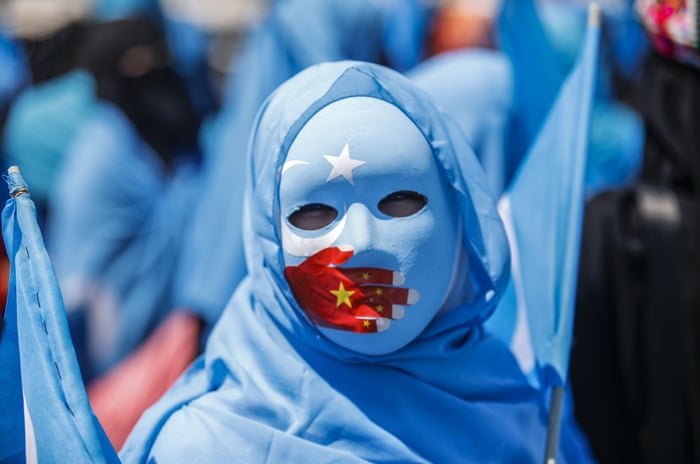 Photograph: Kemal Aslan/Depo Photos via ZUMA Wire/REX/Shutterstock
Photograph: Kemal Aslan/Depo Photos via ZUMA Wire/REX/Shutterstock
- Pratyush Singh
China has been condemned time and again for its iniquitous treatment of ethnic minorities. Reports from numerous human rights groups have revealed that the Chinese government has been systematically erasing the culture and identity of communities like the Uyghurs, Kazakhs, and other Turkic minorities [1]. Until now, the Chinese government’s assault on these communities was believed to be an ethnocide or a cultural genocide as it was presumed that the measures taken by China were employed to subjugate and eventually eliminate the culture of the religious minorities, in order to assimilate them into the atheistic ideology of the Communist Party of China. However, new evidence suggests that the Chinese government has also been actively making an effort to cull the population of the ethnic minorities, which brings into question the possibility of physical genocide.
As per Article II of the Convention on the Prevention and Punishment of the Crime of Genocide, the crime of genocide has two elements. The first element is the mental element or the intent [2]. The article states that genocide must be committed with the intent to destroy, in whole or in part, a national, ethnic, racial, or religious group. The second element is the physical element, that is, a tangible act by the means of which genocidal intent is executed. If an act meets the definition laid by Article II of the convention it can be called genocide and punished under Article III [3]. It is important to note that ‘intent’ here is the specialized intent to destroy the population of a community or dolus specialis [4].
Therefore, the elimination of the culture of a community is not a genocide, which is why the overt destruction of Uyghur culture so far could not be called a genocide. However, a recent study conducted by Dr. Adrian Zenz points towards the possibility of forceful measures being taken by China to curb the population of its minorities [5]. This comes after numerous testimonies from Uyghur women who claim that they had been forcefully sterilized at the detention camps [6]. The study that analyzed official policy documents from local county administrations found that the Chinese government had set specific targets for the sterilization of women in Uyghur dominated counties of Xinjiang province. For example, a target of 14 to 34 percent of all women between the age of 18 and 49 was set for the counties of Hotan and Guma [7].
A corresponding decline in population growth rates was also discovered which further corroborates the claim. This suggests that the Chinese government has imposed measures intended to prevent births within the minority communities, which clearly meets the criteria defined by Article II(d) of the genocide convention. While in and of itself the study may not be enough to conclusively prove the commission of genocide, it still provides enough evidence to incite serious concerns that need to be investigated further.
The possibility of genocide also forces us to consider another important legal aspect, which is finding the appropriate mechanism to hold the Chinese government accountable. While the mandate to punish genocide lies with the International Criminal Court, since China is not a party to the Rome Statute treaty it cannot be tried by the ICC.
However, the recent International Court of Justice judgement in The Gambia v Myanmar [8] may have provided another avenue for justice. In The Gambia v Myanmar, the ICJ held that any state party to the genocide convention “is entitled to invoke the responsibility of another state party for the breach of its obligations, without having to prove a special interest” [9]. This is because the obligations under the genocide convention are ‘erga omnes partes’ or owed by a state to all the other states party to the convention. This is particularly significant because the ICJ judgement evinces that a shared interest to prevent the commission of genocidal acts exists between the parties to the genocide convention. Since China is a party to the convention there exists an obligation on it which may be invoked if genocide is conclusively proved.
[1] Human Rights Watch, ‘Eradicating Ideological Viruses: China’s Campaign of Repression Against Xinjiang’s Muslims.’ <https://www.hrw.org/report/2018/09/09/eradicating-ideological-viruses/chinas-campaign-repression-against-xinjiangs>
[2] Convention on the Prevention and Punishment of the Crime of Genocide, 1948 Article 2
[3] Convention on the Prevention and Punishment of the Crime of Genocide, 1948 Article 3
[4] United Nations, ‘Genocide Prevention and the Responsibility to Protect.’
< https://www.un.org/en/genocideprevention/genocide.shtml>
[5] Zenz, A., ‘Sterilizations, IUDs, and Mandatory Birth Control: The CCP’s Campaign to Suppress Uyghur Birthrates in Xinjiang,’: Jamestown Foundation. <https://jamestown.org/wp-content/uploads/2020/06/Zenz-Internment-Sterilizations-and-IUDs-UPDATED-July-21-Rev2.pdf?x90091>
[6] Heritage, ‘China’s Forced Sterilization of Uighur Women Is Cultural Genocide.’
< https://www.heritage.org/asia/commentary/chinas-forced-sterilization-uighur-women-cultural-genocide>
[7] Zenz, A., ‘China’s Own Documents Show Potentially Genocidal Sterilization Plans in Xinjiang.’
<https://foreignpolicy.com/2020/07/01/china-documents-uighur-genocidal-sterilization-xinjiang/>
[8] Application of the Convention on the Prevention and Punishment of the Crime of Genocide (The Gambia v. Myanmar) (Jan. 23, 2020) <https://www.icj-cij.org/en/case/178>
[9] https://www.icj-cij.org/files/case-related/178/178-20200123-ORD-01-00-EN.pdf

